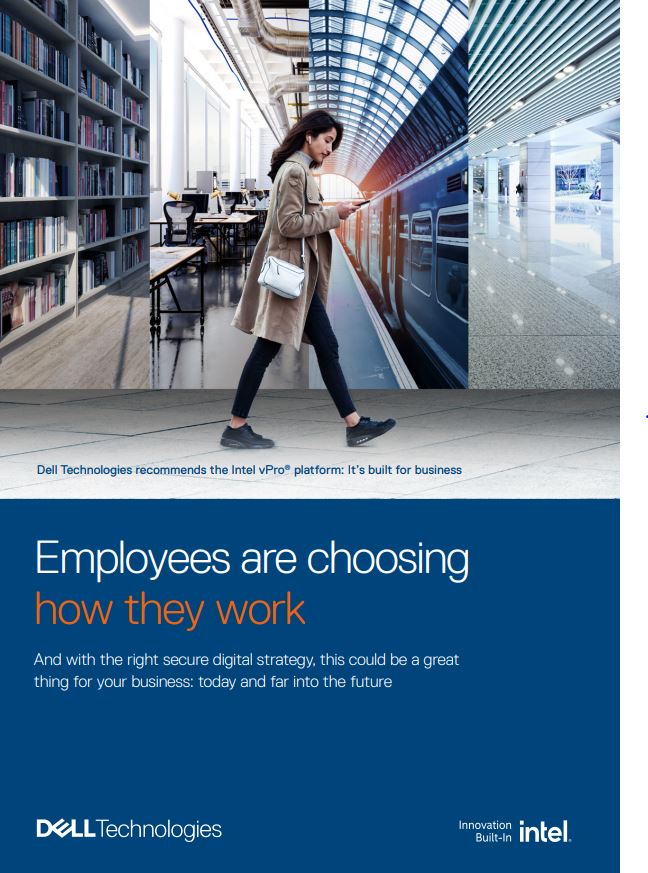Using cutting-edge tech to lure top talent
Organisations are increasingly offering must-have hardware and digital devices to recruit and retain the skilled employees they need

What many refer to as the ‘great resignation’ means employers are fishing in an ever-decreasing talent pool, with the ongoing skills crisis also adding pressure.
Employment packages may have previously included company cars, healthcare plans, pensions, sabbaticals and the infamous ‘casual Friday’. COVID-19 forced employers to rethink their approach to organising their workforce. The pandemic forced workers, too, to re-evaluate their priorities, as hybrid work emerged as a major trend.
In today’s landscape, technology is essential for staying connected to coworkers and collaborating, which is why employers are ditching the perks of old and increasingly throwing all kinds of hardware and services into the incentives pot – from shiny new business laptops to paid-for broadband bills. Amid businesses vying to attract the most talented individuals, this is a trend many organisations are employing to stay ahead of the curve.
Tech perks vs tech necessities
For most workers, a hybrid approach to work is the preferred option, but there are implications. Since the pandemic, for instance, many have been onboarded without setting foot in an office, while others say they’ll quit if forced to return to a physical workplace. Providing the right technology, therefore, is increasingly important.
“For some staff, a powerful device on offer is part of their consideration as to whether they should join a company,” says Howard Lewis, Surface business group lead at Microsoft UK. But there’s some difference of opinion, Lewis admits, on whether tech provision is a perk or merely a tool of the trade. “Some view it in the same manner as a company car,” Lewis adds, while “others view a powerful device as the bare minimum for getting their work done”.
Whether it’s a perk or necessity, there’s little doubt that tech provision makes a difference when employees decide who to work for. Employees, too, have upped their expectations in the last couple of years. The devices that got them through the pandemic don’t fit the demands of a longer-term, hybrid future, where a lot of work will be done on the go. Whether it’s in the form of sheer power, the form factor, portability or functionality, employees want more from their work-issued hardware – so what can companies realistically offer?
The devices powering hybrid work
Connectivity and portability are essential components of hybrid working. According to a report by Intel – which let’s not forget has skin in this game – employers are likely to look to 5G-enabled laptops for greater security than letting employees rely on open Wi-Fi networks. Dual-screen devices are also popular, according to both Intel and Microsoft, with the latter saying they offer “the agility and flexibility needed for hybrid working”.
Sign up today and you will receive a free copy of our Future Focus 2025 report - the leading guidance on AI, cybersecurity and other IT challenges as per 700+ senior executives
Others, including specific industries, will favour a Mac for hybrid working. “Many of our bread-and-butter customers are creative marketing and design agencies that have historically been Mac-orientated,” says James Godfrey, managing director of Lease Loop, a company that leases Apple hardware. He describes the popularity of Apple devices as “the magpie effect”, with everybody flocking to a new, shiny device Apple might be talking about. The most popular leased device since COVID-19 started is the MacBook Pro 13in, he adds.
As important as the devices are, employees expect the digital experience to match what they’re used to with consumer devices. Most people have tablets and smartphones for personal use, which are easy to operate; they expect the same from their work systems, according to Applaud HR research, with a report suggesting there are widespread expectations for work tech to perform on par with the most popular consumer apps.
Likewise, Godfrey believes it’s vital for IT departments to deliver “zero-touch deployment” so employees receive devices with pre-populated apps that work out of the box. Factors like single sign-on (SSO), and giving employees the right software and the best collaboration tools are important. Simpler interfaces also reduce some of the anxiety around platform choices, he adds. “Since the prevalence of the iPhone and iPad in the home environment, and the advent of Microsoft Surface, the fear factor of moving from Mac to PC is diminishing because of the intuitive way you move around those systems.”
Giving employees the freedom to choose
Perhaps the greatest perk is the ability for employees to choose their hardware. Nine out of ten employees would take a pay cut to secure their device of choice, according to Jamf, with people more likely to join a company if it offers them a technology choice.
Sarah Whitman, senior vice president and head of global e-commerce at employee reward company, Workhuman, agrees. “Workhuman works with hundreds of companies all over the world who are looking to understand what perks, benefits, and rewards employees are looking for – especially now, considering the ongoing talent crisis and consequent battle to attract and retain top talent. We’ve found that when it comes to the most appealing tech perks, the ability to choose is key.”
RELATED RESOURCE

Employees are choosing how they work
And with the right secure digital strategy, this could be a great thing for your business: today and far into the future
Andrew Hewitt, a senior analyst for Forrester Research, agrees a choice of device is likely to be a differentiating factor for prospective employees. “If someone is deciding between Company A versus company B, and Company B provides $1,500 to get fully set up and I can choose my device, that’s going to be more attractive than a corporate PC that restricts what I can do,” he says.
There’s a disconnect, however, between employers, who believe they’re quite flexible, and workers on the ground, who feel their choices are being restricted. A majority (84%) of IT decision makers say employees can choose a different form factor, according to Forrester, with 79% saying employees can upgrade devices. However, only half of the employees agree with the statement. This can lead to disgruntled employees, with over half surveyed agreeing their PCs are out-of-date or insufficient.
Kitting out the home office
Employees would expect their companies to kit out their desk at work, but the shift to home-working means they’re also looking for their employers to augment their home office setups. “Prior to 2020, you’d put up with some of the negative consequences of homeworking,” says Hewitt. “So, maybe I need to pay for the internet bill or invest to ensure I have a comfortable office.” He adds employees often felt organisations make an exception for remote working, so these are added costs the employee should cover. This has eroded, and it’s now a question of how well employers support remote work.
It’s not only the laptops that staff demand, but the accessories that go with them. IT decision makers believe accessories are essential – top of the wishlist are wireless headphones, a monitor, an additional keyboard and an external mouse, according to Microsoft. “This provision of a broader ‘day-one kit’ should now be considered for existing staff, when refreshing devices and when onboarding new staff,” Microsoft’s report states. A separate Lenovo report, meanwhile, states most IT decision makers say their company will cover the cost for most technology devices needed or wanted by employees.
Don’t necessarily expect that to extend to your broadband connection, however. Lockdown prompted some employers to cover broadband costs, but that’s far from common practice, according to Alex Bloor, general manager at ISP Andrews & Arnold. “Lots of companies during the lockdown put decent broadband into their employees’ homes so they could work more efficiently,” he says. “However, it was rare for people not to have broadband already. They did it because of support – so that one ISP could support all their employees internally. I find it hard to see it as a perk in the traditional sense.”
Tech satisfaction means career satisfaction
When technology doesn’t live up to expectations, employee productivity and wellbeing can suffer – and some employees are switching jobs as a result. According to NexThink research, 77% of HR and IT leaders think poor or unreliable IT services and equipment play a role in employee burnout or turnover.
A failure to invest also means employees will go elsewhere, according to Applaud HR, with the gap between organisations prioritising the digital experience and those not doing so widening. While many employers have embraced the new normal, others are silently waiting for things to go back to the way they were, Applaud HR’s report suggests. This is already having a profound impact on staff retention, productivity, and wellbeing.
“If things go awry, you start having significant issues,” Hewitt agrees. “People start to say, I can’t get my job done because the technology is suffering. Several clients have said that they’ve heard in their exit interviews that people are leaving because the technology doesn’t enable them to be successful.”
With technology proving ever more critical to recruitment and retention, employers are also investing in skills to enhance the digital experience. By 2025, half of IT organisations will have established a digital employee experience strategy, team and management tool, a significant increase from 5% in 2021, according to Gartner.
Companies must also upskill staff to help them take advantage of sleeker tools, says Multiverse, a startup that works with businesses to offer apprenticeships to young adults and those looking to reskill. “The fastest-growing areas of our economy are data, tech and digital skills,” says Jeremy Duggan, president at Multiverse. “One of the best things companies can do to support their people right now is to provide fully-funded training in these areas – giving their people the ability to own their career progression in high-demand areas.”
The message is clear. If employers want to retain their staff and attract the skilled workers they need, they need to give them the tools – both hardware and soft skills – to do it.
-
 Pure DC’s announces 'Europe’s largest standalone hyperscale data center lease' in Amsterdam — but who is the mystery customer?
Pure DC’s announces 'Europe’s largest standalone hyperscale data center lease' in Amsterdam — but who is the mystery customer?News The company is now constructing a 78MW campus in Westpoort, Amsterdam
-
 Cloud security teams are in turmoil
Cloud security teams are in turmoilNews Cloud security teams are scrambling to keep pace with expanding attack surfaces, new research from Palo Alto Networks shows, largely due to the rapid adoption of enterprise AI solutions.
-
 Infosys co-founder Narayana Murthy called for a 70 hour week last year — now he says that’s not enough
Infosys co-founder Narayana Murthy called for a 70 hour week last year — now he says that’s not enoughNews Murthy thinks longer hours akin to China’s '996' approach are the key to success
-
 Microsoft could be preparing for a crackdown on remote work
Microsoft could be preparing for a crackdown on remote workNews The tech giant is the latest to implement stricter policies around hybrid working without requiring a full five days in the office
-
 IT professionals aren’t budging on flexible work demands – and more than half say they’ll quit if employers don’t meet expectations
IT professionals aren’t budging on flexible work demands – and more than half say they’ll quit if employers don’t meet expectationsNews Analysis from Randstad shows 40% of UK-based IT pros have quit over a lack of flexible work options, while 31% of workers globally have done the same.
-
 'The tide seems to be turning towards office attendance': 64% of hybrid business leaders want staff back in the office – but many worry that enforcing RTO mandates will drive employees away
'The tide seems to be turning towards office attendance': 64% of hybrid business leaders want staff back in the office – but many worry that enforcing RTO mandates will drive employees awayAnalysis Many UK business leaders want their staff back in the office more frequently, but they’re scared to implement return to office (RTO) mandates in fear of worker revolts.
-
 Employees are dead set on flexible working arrangements – three quarters would turn down a role that didn't offer hybrid options as work-life balance becomes more important than pay
Employees are dead set on flexible working arrangements – three quarters would turn down a role that didn't offer hybrid options as work-life balance becomes more important than payNews New research shows workers are increasingly demanding flexible working arrangements from employers.
-
 Nearly half of tech workers are seeking new roles – declining employee benefits and reduced flexible working options have staff looking elsewhere
Nearly half of tech workers are seeking new roles – declining employee benefits and reduced flexible working options have staff looking elsewhereNews While salaries are rising for tech workers, other benefits are in decline, leading to a fall in job satisfaction
-
 Untethered: How CIOs and CISOs are paving the way for the new hybrid workforce
Untethered: How CIOs and CISOs are paving the way for the new hybrid workforceWhitepaper Effective techniques to transition from exposed legacy infrastructure to an effective zero trust strategy
-
 Unified endpoint management and security in a work-from-anywhere world
Unified endpoint management and security in a work-from-anywhere worldWhitepaper Learn how to converge endpoint management and security processes and systems to drive efficiency and reduce risk